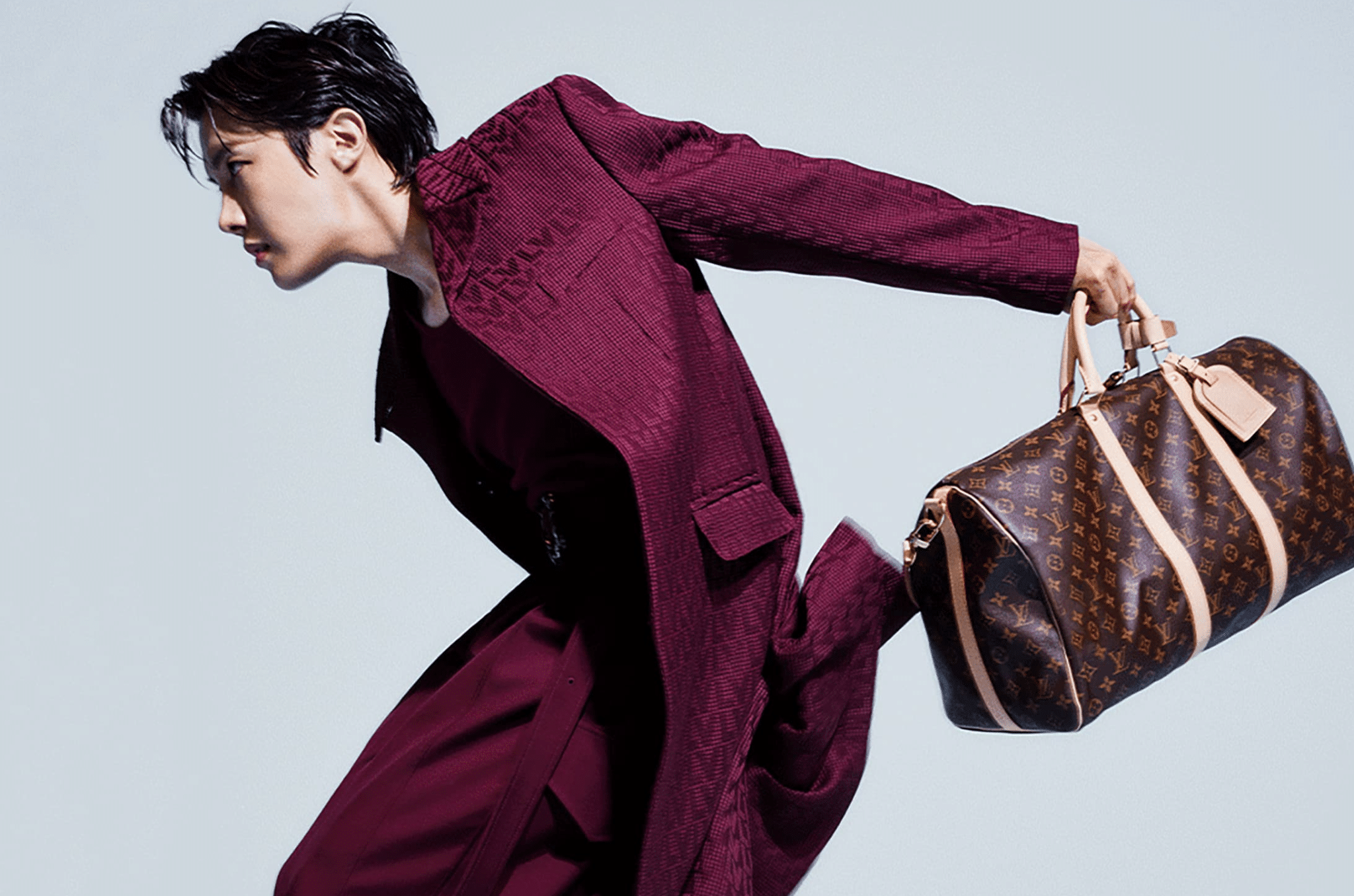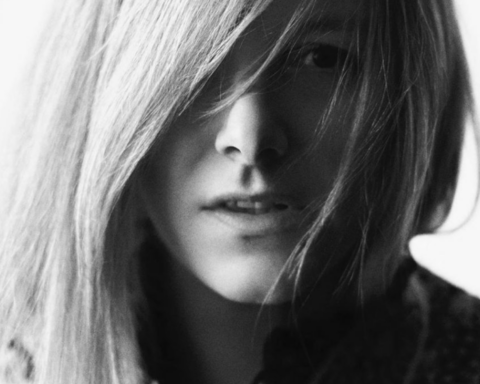[vc_row njt-role=”people-in-the-roles” njt-role-user-roles=”administrator,editor,author,armember”][vc_column][vc_column_text]
For the luxury goods industry, territorial expansion in South Korea means more than just opening concept flagships or staging grandiose fashion shows. It’s also about capitalizing on the ever-growing export of Made By Korea cultural products, such as K-pop music. To achieve this, brands no longer hesitate to recruit influential local stars with a pan-Asian aura: the Idols.
1997: South-East Asia faces an unprecedented financial crisis. To cope, South Korea, until then specialized in heavy industry, opted for soft power and the export of its cultural products.
Thirty years later, the country that is one of the four Asian Dragons – along with K-pop – has carved out a place for itself on the global luxury market, attracting almost 30 million fans with its music, TV series and Idols. So much so that, at a time when sales in China are slowing down, the major luxury groups are moving closer to this pan-Asian market that seems to have no limits.
So much so, in fact, that a growing number of luxury brands this year hired an ambassador from the Korean music scene.
A world just as demanding as the hushed world of luxury, renowned for its excellence of execution and recognized for its spectacular and highly positive sensory experiences.
More than groups with near-perfect aesthetics in the tradition of BTS, Aespa, BlackPink and New Jeans, Western luxury brands are seeking to capitalize on the enthusiasm they generate on an Asian and global scale, and above all to capture the attention of their community, reputed to be among the most fervent and committed.
The latest move is Louis Vuitton’s recruitment of J-Hope, rapper-singer-composer of the globally successful group BTS, as ambassador for its Keepall bag, marking the meeting of two icons.
The story of an influential Korean wave – the Hallyu – which, in 2023, will become a tidal wave.
Optimistic soft power
Neighboring one of Asia’s last military and nuclear dictatorships, South Korea also boasts one of the world’s highest suicide rates. Nevertheless, the Land of the Morning Calm is seen as an example of optimism through its cultural productions.
Unlike Japan, whose production and distribution methods it has rapidly perfected, the country’s soft power can rival that of America, whose narrative is steadily losing its desirability, particularly since the advent of Donald Trump as president.
Soft power is a concept coined in 1990 by international relations analyst and theorist Joseph Nye. It is defined as “the ability [of a state] to seduce and attract” in a non-coercive way through cultural or ideological elements.
An alternative narrative in tune with the times
If Hallyu fascinates and attracts more and more followers, it’s also because this cultural product offers, according to the analysis of Vincenzo Cicchelli and Sophie Octobre in their book K-pop, soft power et Culture Globale, “an alternative model of pop culture”, at once aesthetic, optimistic, pan-Asian, inclusive and, above all, post-colonial. In contrast, the United States, long the world’s cultural landmark, has lost some of its aura.
This is due to a political landscape mired in racism and sexual harassment, a consumer society deemed to be out of control, and a cultural imperialism that Uncle Sam is increasingly criticized for by emerging countries and minorities on their soil (Asians, Latinos and Afro-Americans).
Two days 4 years apart illustrate the growing ascendancy of K-pop over hitherto dominant American culture.
The 2019 edition of the Billboard Awards – the annual ceremony that crowns the most popular musical hits in the USA – welcomes South Korean group BTS for the first time. On stage, the group shares the bill with Halsey – American singer-songwriter, poet, make-up designer and actress – for their joint track 작은 것들을 위한 시 Boy With Luv. In the hall, it’s an euphoria rarely heard across the Atlantic, even masking the singers’ voices on stage.
It was the same scene of jubilation last April on the set of Jimmy Fallon’s late show. The American host, known for his good humor and versatility, welcomed another “multipurpose artist”: Jimin, leader of the group BTS, for the launch of his solo album “Face”.
Here again, he has to deal with hysterical fans at every mention of their idol and every word he says, to the point of recalling the days when the Beatles were greeted by a frenzied crowd from the moment they stepped off the plane to the moment they arrived on stage.
Although the two artists play the comedy perfectly here – including with the king of American talk shows, who goes so far as to ask for stage advice – the effect this “Jimin Fallon” has on the audience leaves no doubt about the development of the K-pop phenomenon.
A phenomenon that the American media sensed before anyone else, being the only ones to invent the members of the BTS group on their sets.
A surge from Korea
Behind this phenomenon is the Hallyu, literally “Korean wave”.
As Sylvie Octobre, sociologist at the French Ministry of Culture’s Department of Aesthetic Prospective, researcher at the Max Weber Center and co-author of the book K-pop, soft Power et culture globale with Vincenzo Cicchelli, explains, this is a word originally coined in the 1990s by a Chinese journalist to critically describe the invasion of Korean products into his country. At the time, these were mainly TV series (or K-dramas). These series quickly became veritable vessels for indirectly promoting a wide range of Korean products.
The notion eventually outgrew its creator, as Vincenzo Cicchelli concedes, to the point of designating everything to do with Korean cultural products, which in the space of 50 years went from Made for Korea to Made by Korea.
Since then, these aesthetic cultural products have ceased to be a source of shame in their country of origin, and have become a showcase for local know-how.
In the next instalment, we’ll take a closer look at the extreme diversity of cultural products that first found their way to Southeast Asia, before making their way to the Western world.
An opportunity to discover how the pupil (South Korea), by dint of observation and adaptation, has finally surpassed the master (Japan).
Featured photo : © Dr. Jart+ [/vc_column_text][/vc_column][/vc_row][vc_row njt-role=”not-logged-in”][vc_column][vc_column_text]
For the luxury goods industry, territorial expansion in South Korea means more than just opening concept flagships or staging grandiose fashion shows. It’s also about capitalizing on the ever-growing export of Made By Korea cultural products, such as K-pop music. To achieve this, brands no longer hesitate to recruit influential local stars with a pan-Asian aura: the Idols.
1997: South-East Asia faces an unprecedented financial crisis. To cope, South Korea, until then specialized in heavy industry, opted for soft power and the export of its cultural products.
Thirty years later, the country that is one of the four Asian Dragons – along with K-pop – has carved out a place for itself on the global luxury market, attracting almost 30 million fans with its music, TV series and Idols. So much so that, at a time when sales in China are slowing down, the major luxury groups are moving closer to this pan-Asian market that seems to have no limits.
So much so, in fact, that a growing number of luxury brands this year hired an ambassador from the Korean music scene.
A world just as demanding as the hushed world of luxury, renowned for its excellence of execution and recognized for its spectacular and highly positive sensory experiences.
More than groups with near-perfect aesthetics in the tradition of BTS, Aespa, BlackPink and New Jeans, Western luxury brands are seeking to capitalize on the enthusiasm they generate on an Asian and global scale, and above all to capture the attention of their community, reputed to be among the most fervent and committed.
The latest move is Louis Vuitton’s recruitment of J-Hope, rapper-singer-composer of the globally successful group BTS, as ambassador for its Keepall bag, marking the meeting of two icons.
The story of an influential Korean wave – the Hallyu – which, in 2023, will become a tidal wave.
Optimistic soft power
Neighboring one of Asia’s last military and nuclear dictatorships, South Korea also boasts one of the world’s highest suicide rates. Nevertheless, the Land of the Morning Calm is seen as an example of optimism through its cultural productions.
Unlike Japan, whose production and distribution methods it has rapidly perfected, the country’s soft power can rival that of America, whose narrative is steadily losing its desirability, particularly since the advent of Donald Trump as president.
Soft power is a concept coined in 1990 by international relations analyst and theorist Joseph Nye. It is defined as “the ability [of a state] to seduce and attract” in a non-coercive way through cultural or ideological elements.
An alternative narrative in tune with the times
If Hallyu fascinates and attracts more and more followers, it’s also because this cultural product offers, according to the analysis of Vincenzo Cicchelli and Sophie Octobre in their book K-pop, soft power et Culture Globale, “an alternative model of pop culture”, at once aesthetic, optimistic, pan-Asian, inclusive and, above all, post-colonial. In contrast, the United States, long the world’s cultural landmark, has lost some of its aura.
[…][/vc_column_text][vc_cta h2=”This article is reserved for subscribers.” h2_font_container=”tag:h2|font_size:16|text_align:left” h2_use_theme_fonts=”yes” h4=”Subscribe now !” h4_font_container=”tag:h2|font_size:32|text_align:left|line_height:bas” h4_use_theme_fonts=”yes” txt_align=”center” color=”black” add_button=”right” btn_title=”I SUBSCRIBE !” btn_color=”danger” btn_size=”lg” btn_align=”center” use_custom_fonts_h2=”true” use_custom_fonts_h4=”true” btn_button_block=”true” btn_custom_onclick=”true” btn_link=”url:https%3A%2F%2Fluxus-plus.com%2Fen%2Fsubscriptions-and-newsletter-special-offer-valid-until-september-30-2020-2-2%2F”]Get unlimited access to all articles and live a new reading experience, preview contents, exclusive newsletters…
Already have an account ? Please log in.
[/vc_cta][vc_column_text]Featured photo : © Press[/vc_column_text][/vc_column][/vc_row][vc_row njt-role=”people-in-the-roles” njt-role-user-roles=”subscriber,customer”][vc_column][vc_column_text]
For the luxury goods industry, territorial expansion in South Korea means more than just opening concept flagships or staging grandiose fashion shows. It’s also about capitalizing on the ever-growing export of Made By Korea cultural products, such as K-pop music. To achieve this, brands no longer hesitate to recruit influential local stars with a pan-Asian aura: the Idols.
1997: South-East Asia faces an unprecedented financial crisis. To cope, South Korea, until then specialized in heavy industry, opted for soft power and the export of its cultural products.
Thirty years later, the country that is one of the four Asian Dragons – along with K-pop – has carved out a place for itself on the global luxury market, attracting almost 30 million fans with its music, TV series and Idols. So much so that, at a time when sales in China are slowing down, the major luxury groups are moving closer to this pan-Asian market that seems to have no limits.
So much so, in fact, that a growing number of luxury brands this year hired an ambassador from the Korean music scene.
A world just as demanding as the hushed world of luxury, renowned for its excellence of execution and recognized for its spectacular and highly positive sensory experiences.
More than groups with near-perfect aesthetics in the tradition of BTS, Aespa, BlackPink and New Jeans, Western luxury brands are seeking to capitalize on the enthusiasm they generate on an Asian and global scale, and above all to capture the attention of their community, reputed to be among the most fervent and committed.
The latest move is Louis Vuitton’s recruitment of J-Hope, rapper-singer-composer of the globally successful group BTS, as ambassador for its Keepall bag, marking the meeting of two icons.
The story of an influential Korean wave – the Hallyu – which, in 2023, will become a tidal wave.
Optimistic soft power
Neighboring one of Asia’s last military and nuclear dictatorships, South Korea also boasts one of the world’s highest suicide rates. Nevertheless, the Land of the Morning Calm is seen as an example of optimism through its cultural productions.
Unlike Japan, whose production and distribution methods it has rapidly perfected, the country’s soft power can rival that of America, whose narrative is steadily losing its desirability, particularly since the advent of Donald Trump as president.
Soft power is a concept coined in 1990 by international relations analyst and theorist Joseph Nye. It is defined as “the ability [of a state] to seduce and attract” in a non-coercive way through cultural or ideological elements.
An alternative narrative in tune with the times
If Hallyu fascinates and attracts more and more followers, it’s also because this cultural product offers, according to the analysis of Vincenzo Cicchelli and Sophie Octobre in their book K-pop, soft power et Culture Globale, “an alternative model of pop culture”, at once aesthetic, optimistic, pan-Asian, inclusive and, above all, post-colonial. In contrast, the United States, long the world’s cultural landmark, has lost some of its aura.
[…][/vc_column_text][vc_cta h2=”This article is reserved for subscribers.” h2_font_container=”tag:h2|font_size:16|text_align:left” h2_use_theme_fonts=”yes” h4=”Subscribe now !” h4_font_container=”tag:h2|font_size:32|text_align:left|line_height:bas” h4_use_theme_fonts=”yes” txt_align=”center” color=”black” add_button=”right” btn_title=”I SUBSCRIBE !” btn_color=”danger” btn_size=”lg” btn_align=”center” use_custom_fonts_h2=”true” use_custom_fonts_h4=”true” btn_button_block=”true” btn_custom_onclick=”true” btn_link=”url:https%3A%2F%2Fluxus-plus.com%2Fen%2Fsubscriptions-and-newsletter-special-offer-valid-until-september-30-2020-2-2%2F”]Get unlimited access to all articles and live a new reading experience, preview contents, exclusive newsletters…
Already have an account ? Please log in.
[/vc_cta][vc_column_text]Featured photo : © Press [/vc_column_text][/vc_column][/vc_row]










